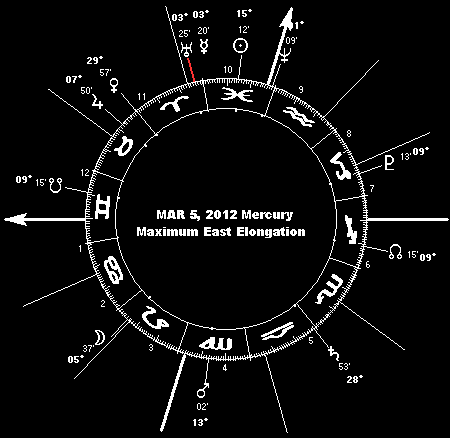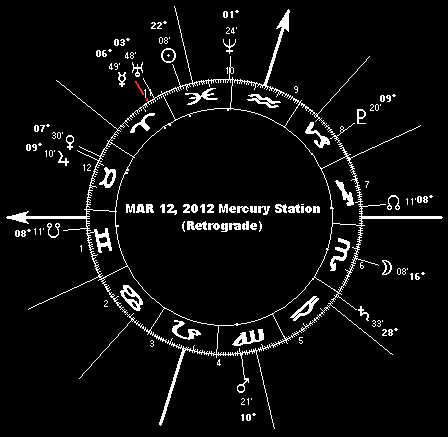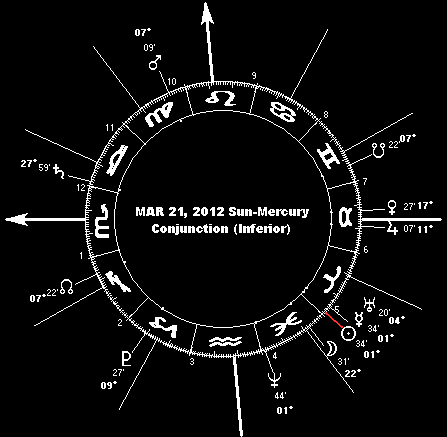PLEASE NOTE: This article incorporates elements of (and refers to) my complete 2012 World Forecast Highlights (34 8-1/2 x 11" illustrated pages). If you’d like your own copy of the full 2012 World Forecast Highlights, it’s available in hard copy by mail ($75) or as a PDF document by email ($50). Orders may be phoned in (toll-free from anywhere in North America to 800-527-8761) and charged to any major credit card. PayPal orders may be placed direct from your own PayPal account page to rnolle@astropro.com – or by using the AstroPro PayPal order page.
 Mercury Max is by and large an unrecognized celestial cycle, although traditional astrology gropes blindly around the edges of the phenomenon and gets it partly right. Being closest to the Sun, Mercury goes between Earth and Sun more than any other planet; several times a year in fact, including the infamous Mercury retrogrades of astrological legend. While most astrologers pay a fair amount of attention to Mercury's retrograde, few realize that it's only a part of the more fundamental Max phase in the orbital interaction between Mercury and Earth, as they both orbit around the Sun. (The accompany animation shows you what's really happening.)
Mercury Max is by and large an unrecognized celestial cycle, although traditional astrology gropes blindly around the edges of the phenomenon and gets it partly right. Being closest to the Sun, Mercury goes between Earth and Sun more than any other planet; several times a year in fact, including the infamous Mercury retrogrades of astrological legend. While most astrologers pay a fair amount of attention to Mercury's retrograde, few realize that it's only a part of the more fundamental Max phase in the orbital interaction between Mercury and Earth, as they both orbit around the Sun. (The accompany animation shows you what's really happening.)
The Mercury Max phase begins when the little Sun-grazer reaches its maximum elongation east of the Sun - its evening star phase. This happens when Mercury has come 'round to the same side of the Sun as Planet Earth, and is relatively near us. The little planet is then pulling up to pass Earth on the inside track, as it were; catching up to us from behind and then passing between us and the Sun. Just as it catches up with us, Mercury passes directly between Earth and the Sun. This is Mercury's inferior conjunction with the Sun. After the inferior conjunction, Mercury continues pulling ahead of us until it reaches its greatest elongation west of the Sun (its morning star phase), at which point the little planet is headed toward the far side of our parent star. Between these two extremes, the greatest east and west elongations, comes the fabled Mercury retrograde period of astrological lore.
 It’s worth noting that with the inferior planets (those inside Earth’s orbit; namely Mercury and Venus), the closest approach to Earth coincides with the inferior (retrograde) conjunction with the Sun. With the superior planets (those outside Earth’s orbit), the closest approach to Earth coincides with the planet’s (retrograde) solar opposition. Clearly astrological doctrine regarding planetary retrogrades is completely unthinking. Rather than being weakened or debilitated in some way, a retrograde planet is in fact bigger and brighter in our sky, and closer to our home planet. Not unlike a SuperMoon, in that respect . . .
It’s worth noting that with the inferior planets (those inside Earth’s orbit; namely Mercury and Venus), the closest approach to Earth coincides with the inferior (retrograde) conjunction with the Sun. With the superior planets (those outside Earth’s orbit), the closest approach to Earth coincides with the planet’s (retrograde) solar opposition. Clearly astrological doctrine regarding planetary retrogrades is completely unthinking. Rather than being weakened or debilitated in some way, a retrograde planet is in fact bigger and brighter in our sky, and closer to our home planet. Not unlike a SuperMoon, in that respect . . .
What I have termed the Mercury Max cycle is a way of putting the Earth-Sun-Mercury relationship into a perspective that reflects real-sky, observational astronomy; the dynamics of our solar system as seen from our home planet perch – which is what astrology was, back in the time when it was astronomy. Look up in the sky over the indicated periods, and you will see the phenomena described above. This perspective replaces the stilted, removed-from-reality practice of looking not at the sky, but at an ephemeris: first to see when Mercury comes to the degree at which it will later makes its direct station, and second when it reaches the degree at which it will later make its retrograde station; and then referring to the overlap between these two dates and the lesser included Mercury retrograde dates as the “shadow” and “storm” phases of the retrograde. (Some astrologers don’t use the “storm” nomenclature, referring to the overlap at both ends of the retrograde as the “shadow” period. It makes no difference: either way, it’s just plain nonsense, promulgated by people who refuse to see the sky. (It’s a variation on that old proverb, “none so blind as those who refuse to look.)
 For example, the first Mercury Max cycle of 2012 begins with the little planet’s maximum eastern elongation from the Sun on March 5, includes the March 12-April 4 retrograde and the March 21 inferior conjunction, and wraps up with the western elongation extreme on April 18, 2012. The corresponding shadow period would begin on February 27 (the day Mercury reaches the degree at which it goes direct on April 4) and ends (or the storm period ends, depending on which irrelevant nomenclature you prefer) on April 23 (the day Mercury returns to the degree at which it went retrograde on March 12). But in terms of any organic, visible manifestation in the skies of our home planet, these ephemeris-derived dates have no relevance to the Earth-Sun-Mercury dynamic. It’s like left-brain versus right-brain thinking, linear versus holistic; nose in the book versus eyes on the skies. One is a made-up abstraction looked up in an ephemeris, the other a reality that can be seen in the sky. The corresponding organically derived dates in this case are March 5 (greatest eastern elongation) and April 18 (western elongation maximum). Occasionally the real Mercury Max begin and end dates will coincide with the artificial so-called shadow period start and stop dates. Even a broken clock is right twice a day. But the reality is there to see in the sky.
For example, the first Mercury Max cycle of 2012 begins with the little planet’s maximum eastern elongation from the Sun on March 5, includes the March 12-April 4 retrograde and the March 21 inferior conjunction, and wraps up with the western elongation extreme on April 18, 2012. The corresponding shadow period would begin on February 27 (the day Mercury reaches the degree at which it goes direct on April 4) and ends (or the storm period ends, depending on which irrelevant nomenclature you prefer) on April 23 (the day Mercury returns to the degree at which it went retrograde on March 12). But in terms of any organic, visible manifestation in the skies of our home planet, these ephemeris-derived dates have no relevance to the Earth-Sun-Mercury dynamic. It’s like left-brain versus right-brain thinking, linear versus holistic; nose in the book versus eyes on the skies. One is a made-up abstraction looked up in an ephemeris, the other a reality that can be seen in the sky. The corresponding organically derived dates in this case are March 5 (greatest eastern elongation) and April 18 (western elongation maximum). Occasionally the real Mercury Max begin and end dates will coincide with the artificial so-called shadow period start and stop dates. Even a broken clock is right twice a day. But the reality is there to see in the sky.
Retrograde means moving backwards. This is what Mercury appears to do in our skies when the little inner planet catches up on us and passes us on the inside, between Earth and the Sun. First Mercury reaches its greatest eastern elongation, then it appears to stand still in the sky (the retrograde station), and then it appears to move backwards through the heavens for a period of several weeks: that's Mercury retrograde for you. It ends when the little Sun-grazer's backwards motion comes to an apparent halt (the direct station); after which, Mercury moves forward again, until it reaches its maximum elongation west of the Sun. The reality of course is that Mercury never stops in its orbit, and never moves backward: this is only how the relative motions of Earth and Mercury around the Sun cause Mercury to move through our night sky.
Mercury retrograde is the cycle when everything goes wrong, to hear some astrologers tell it. The truth is not so simple-minded. All things Mercurial are crucial during the Mercury Max phase; infrastructure, commerce, information, communication and transport being prime examples. Absent careful investigation and planning, and conscientious follow-through, all such things are apt to go off track during these cycles. Mercury's Max phase is a time for focus, concentration, planning, follow-through and communication - all the qualities of the active and involved mind, in short. In case you haven't noticed, most people are not especially alert and focused most of the time. When this kind of sleepwalking runs into Mercury's Max cycle, with its focus on mental acuity, it doesn't take long for things to go awry. If you're sharp and focused and alert, you can avoid a certain amount of this mess. In fact, you can even prosper by concentrating on tasks that center on thought, planning and communication. But you'll still have to dodge all the chaos created by the people who are sleepwalking.
 Among the sort of things to be ready for during the above mentioned Mercury Max cycles: strikes and other disruptions affecting transportation and communication (e.g. postal, phone, mass transit, trucking, airline, shipping, dock and warehouse workers, teachers and all manner of media). Weather both terrestrial and solar (including geomagnetic storms) can play a part in the kind of breakdowns described here, but human effort (and sometimes malicious action) is a part of the mix as well. Power failures due to infrastructure breakdown and computer network disruptions caused by hacker attacks, software vulnerabilities and the like are also just a crossed wire or a keystroke away from a major mess at these times.
Among the sort of things to be ready for during the above mentioned Mercury Max cycles: strikes and other disruptions affecting transportation and communication (e.g. postal, phone, mass transit, trucking, airline, shipping, dock and warehouse workers, teachers and all manner of media). Weather both terrestrial and solar (including geomagnetic storms) can play a part in the kind of breakdowns described here, but human effort (and sometimes malicious action) is a part of the mix as well. Power failures due to infrastructure breakdown and computer network disruptions caused by hacker attacks, software vulnerabilities and the like are also just a crossed wire or a keystroke away from a major mess at these times.
If I had to pick a day to have a backup generator all fueled up and ready to go, a contingency plan in place in case the scheduled or expected didn't come to pass, a day to be especially sharp and steady and focused - it would be during one of these Mercury cycles. Note these dates; be ready with a fallback plan just in case. It's not so much that disaster is destined to strike when Mercury is in its Max phase. Rather, it's that everything pertaining to Mercury becomes crucial; and unless it's treated as such, then it goes awry. More and more, we live in a "just in time" world - and if the slightest delay holds up just one single thing, then a whole process screeches to a halt. Unfortunately, few people keep their eye on the ball with any consistency and diligence. And that's the reason these Mercury cycles tend to turn into Murphy's Law festivals. Practically speaking, this means that having a “just in time” inventory of essentials is risky business at times like this. Don't say I didn't warn you!
Speaking of times to have a backup plan handy, watch those Mercury inferior conjunctions! They’re often accompanied by intensified solar outbursts – CMEs and the like, which an (if the active region of the Sun is pointed in our direction at the time) can stir up geomagnetic activity here. Auroral activity and strong storms are possible at times like this – and in the worst case scenario, these can be associated with damage to satellites in orbit and power transmission systems on our planet’s surface.
I’ve already spelled out the details of the March 5-April 18 Mercury Max cycle, the first one of 2012. Mercury’s June 30 greatest elongation east of the Sun marks the next Max cycle of the little planet, which continues through the July 15-August 8 retrograde and the July 28 inferior conjunction, ending with Mercury’s maximum western elongation on August 16. Finally this year comes the Mercury Max phase that starts with the maximum eastern elongation on October 26, includes the November 6-26 retrograde and the November 17 inferior conjunction, and wraps up with the western elongation extreme on December 4, 2012. These are the days and periods to watch, to be ready with a backup plan, to do your follow-ups and due diligence to the utmost. The table below summarizes the 2012 Mercury Max cycles at a glance, using the following abbreviations: Max-E = Maximum Elongation East of Sun (Max begins); S-Rx = Retrograde Station (Retrograde begins); INF CNJ = Inferior Conjunction with the Sun; S-D = Direct Station (Retrograde ends); and Max-W = Maximum Elongation West of Sun (Max ends). This table is on the reverse side of the business card I send my clients, by the way.
| Max-E |
S-Rx |
INF CNJ |
S-D |
Max-W |
| MAR 05 |
MAR 12 |
MAR 21 |
APR 04 |
APR 18 |
| JUN 30 |
JUL 15 |
JUL 28 |
AUG 08 |
AUG 16 |
| OCT 26 |
NOV 06 |
NOV 17 |
NOV 26 |
DEC 04 |